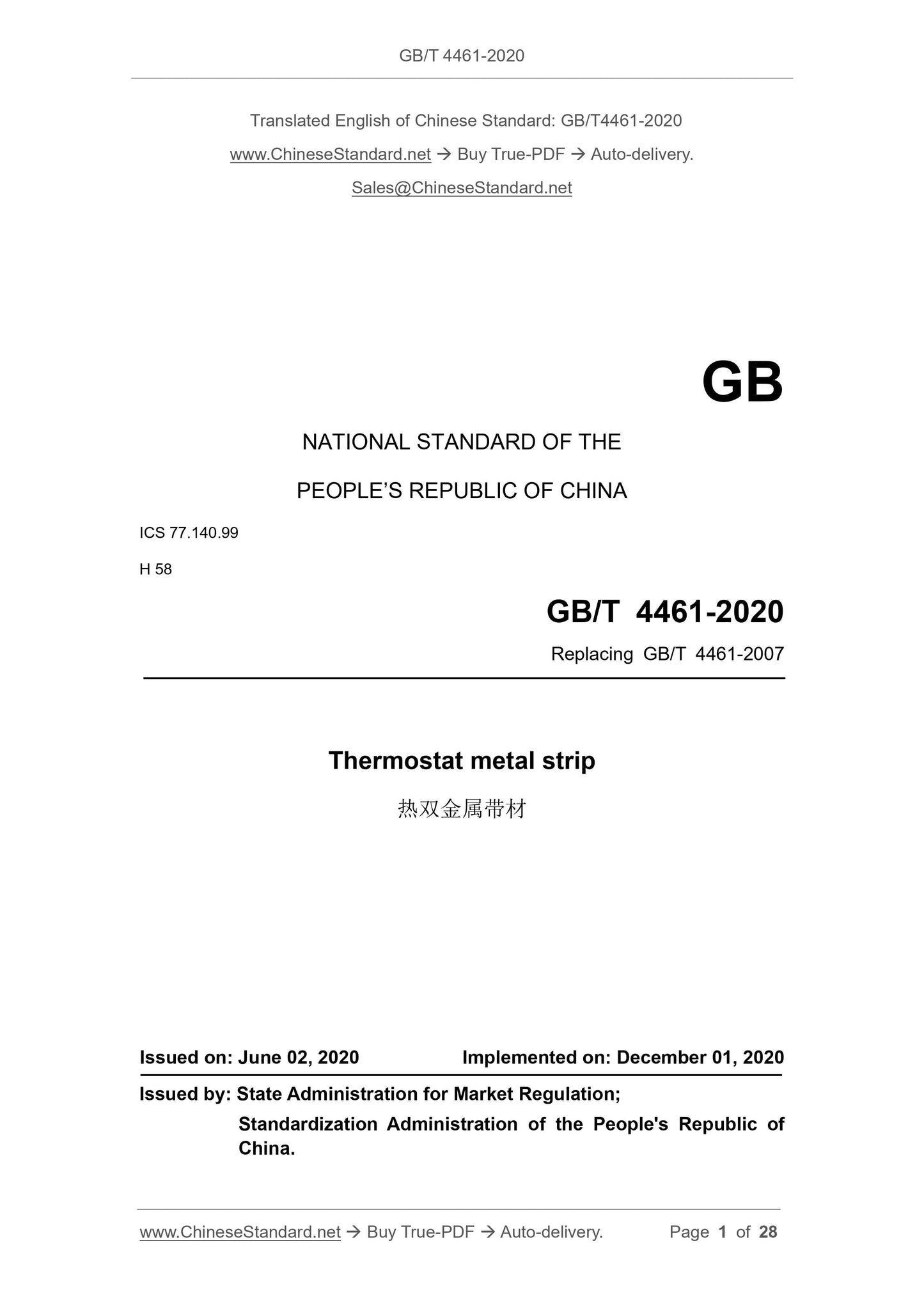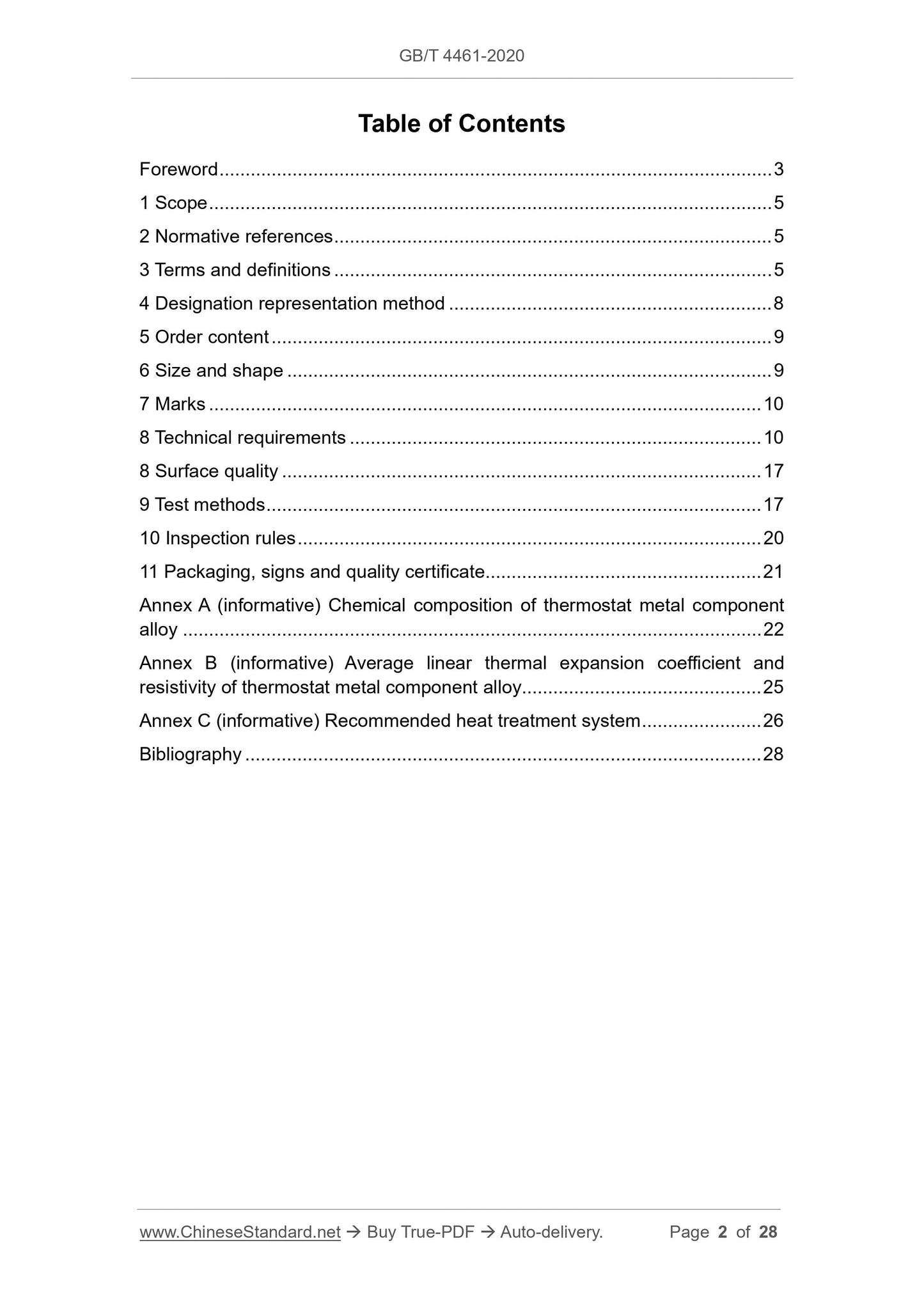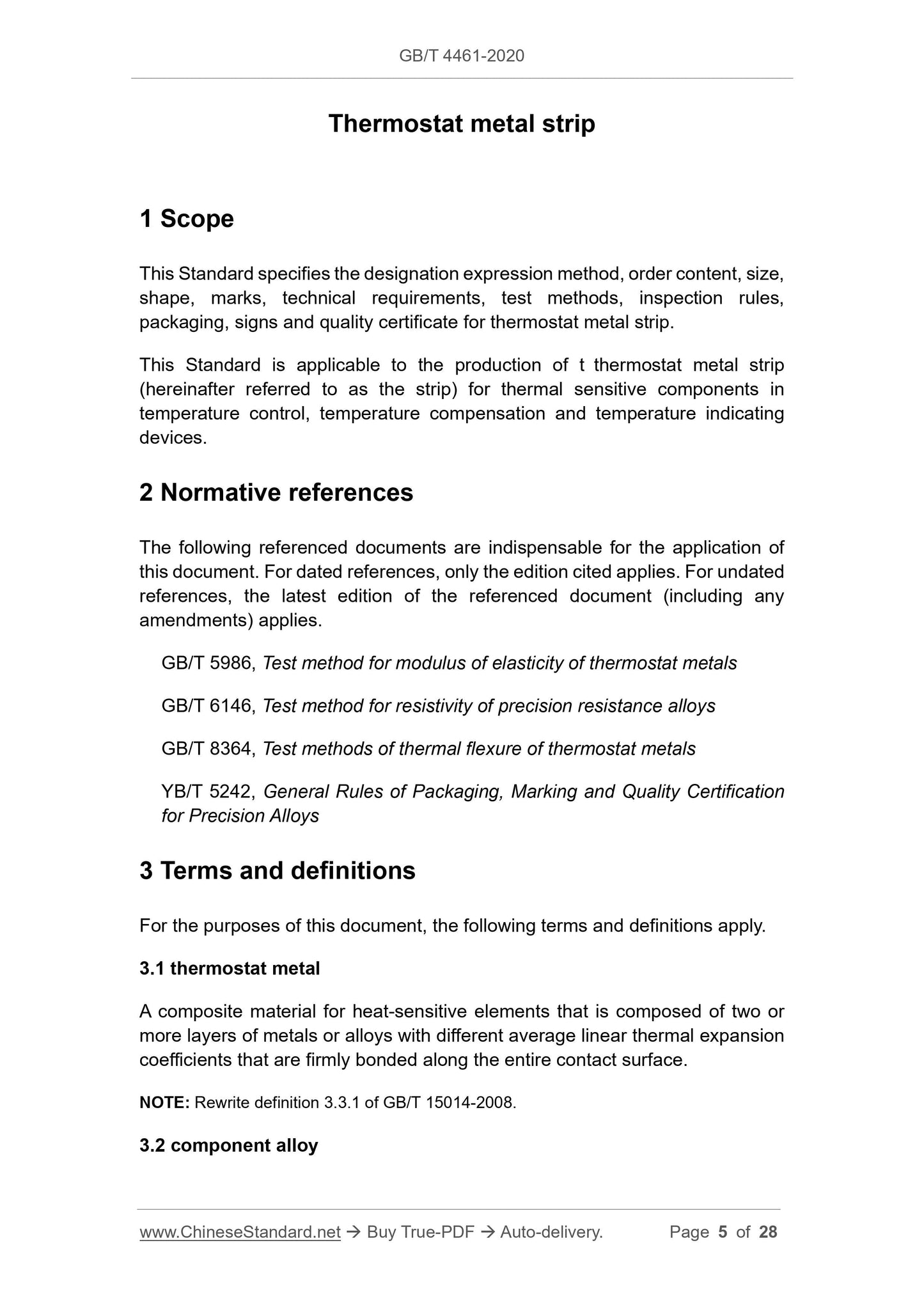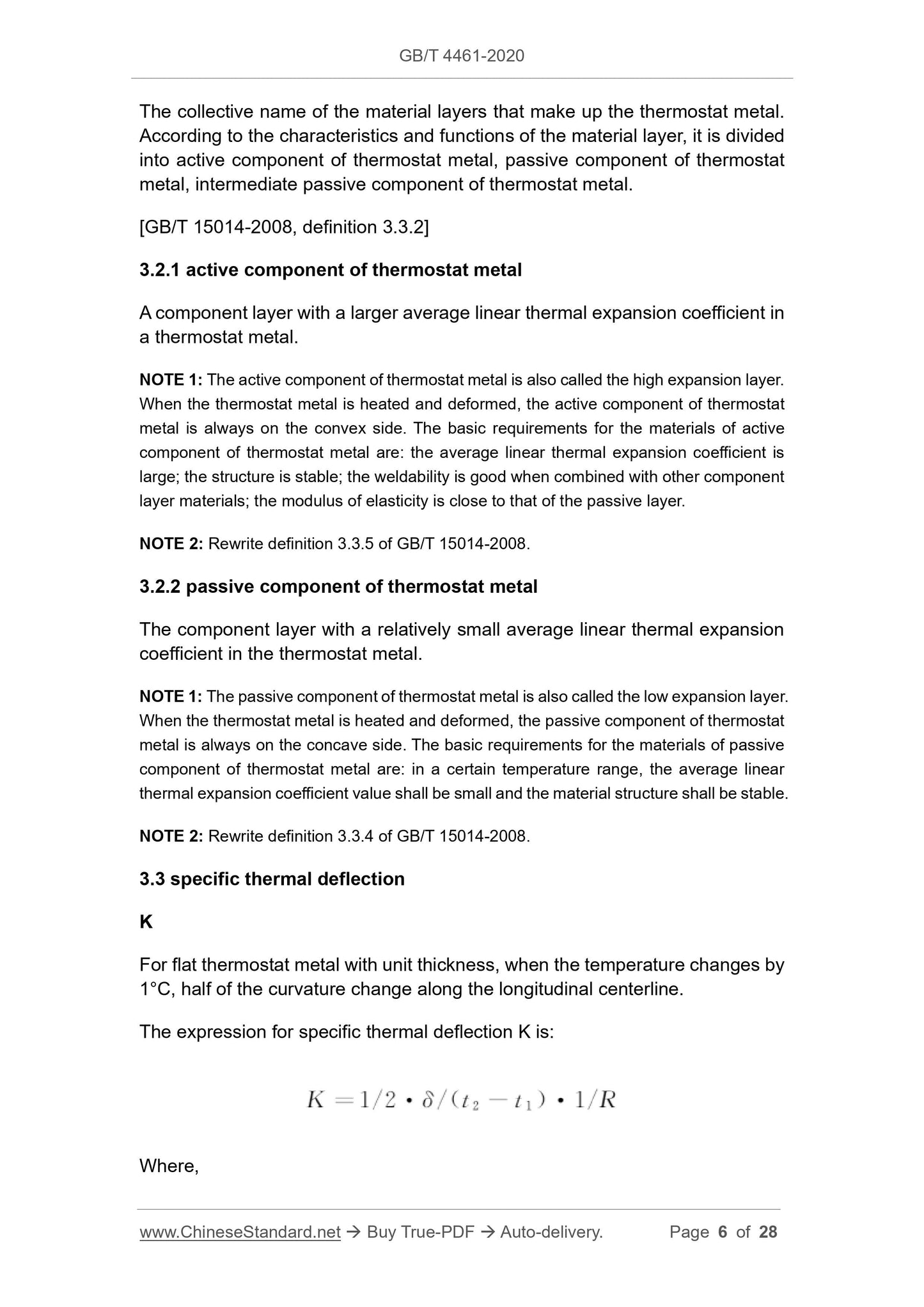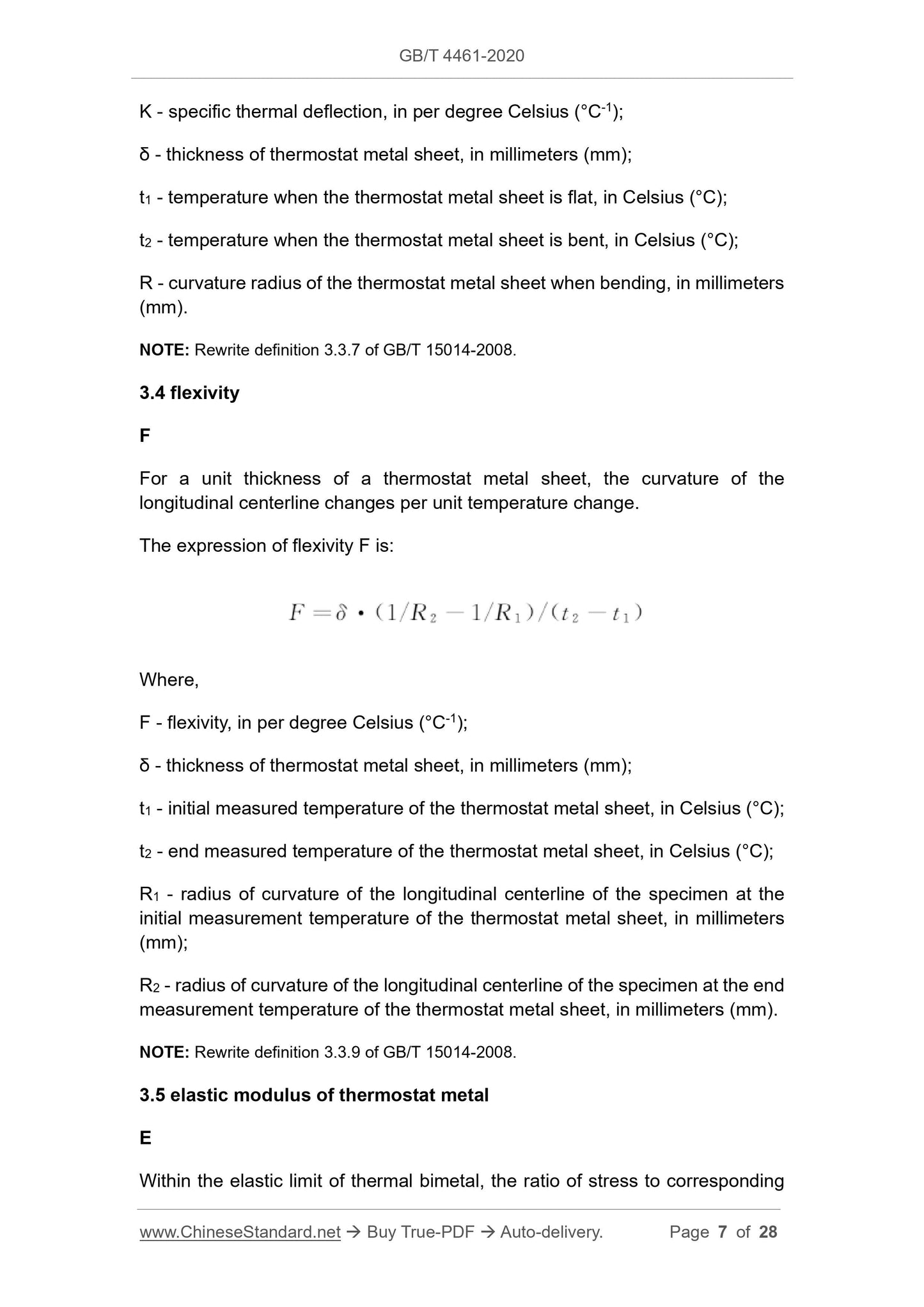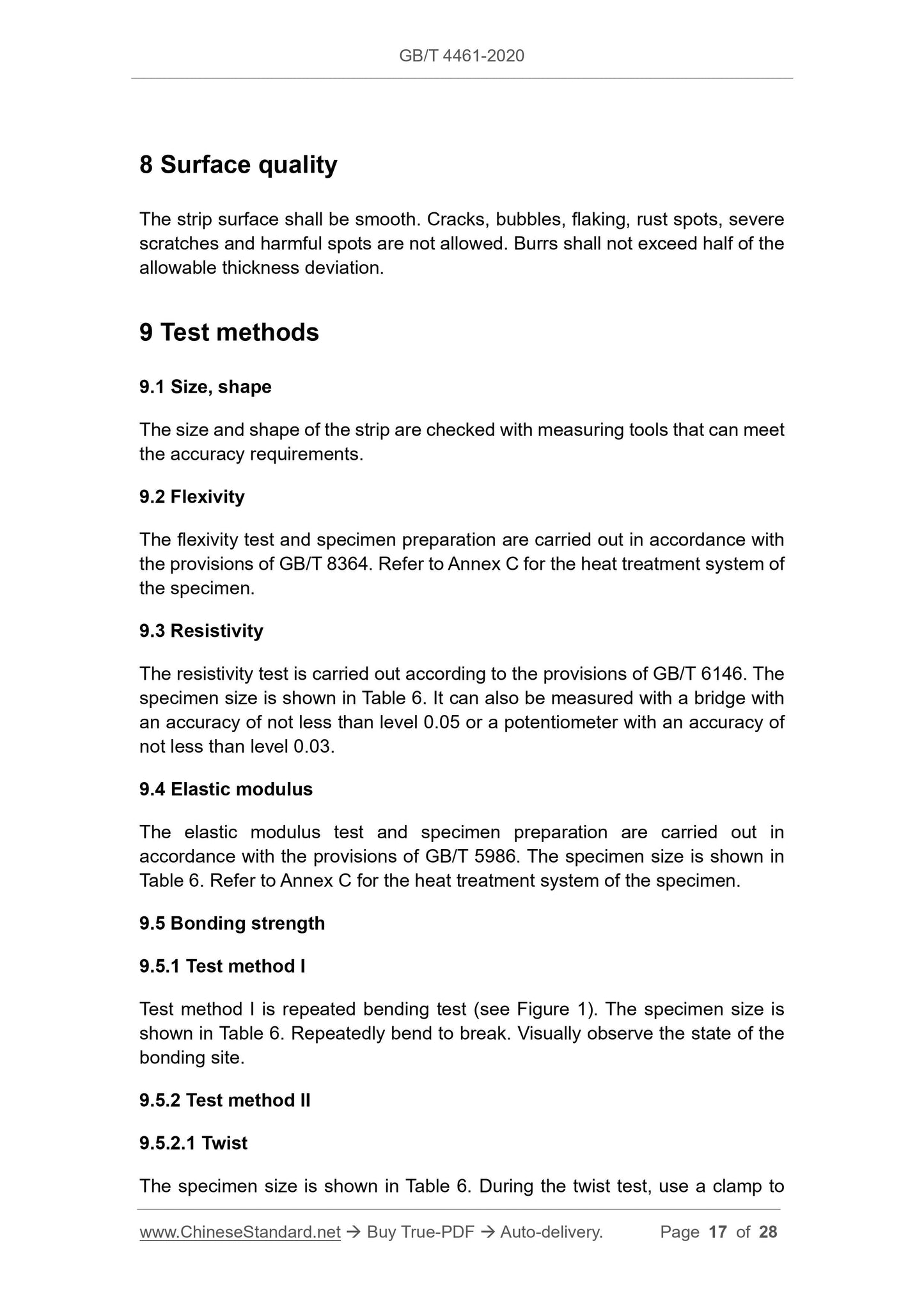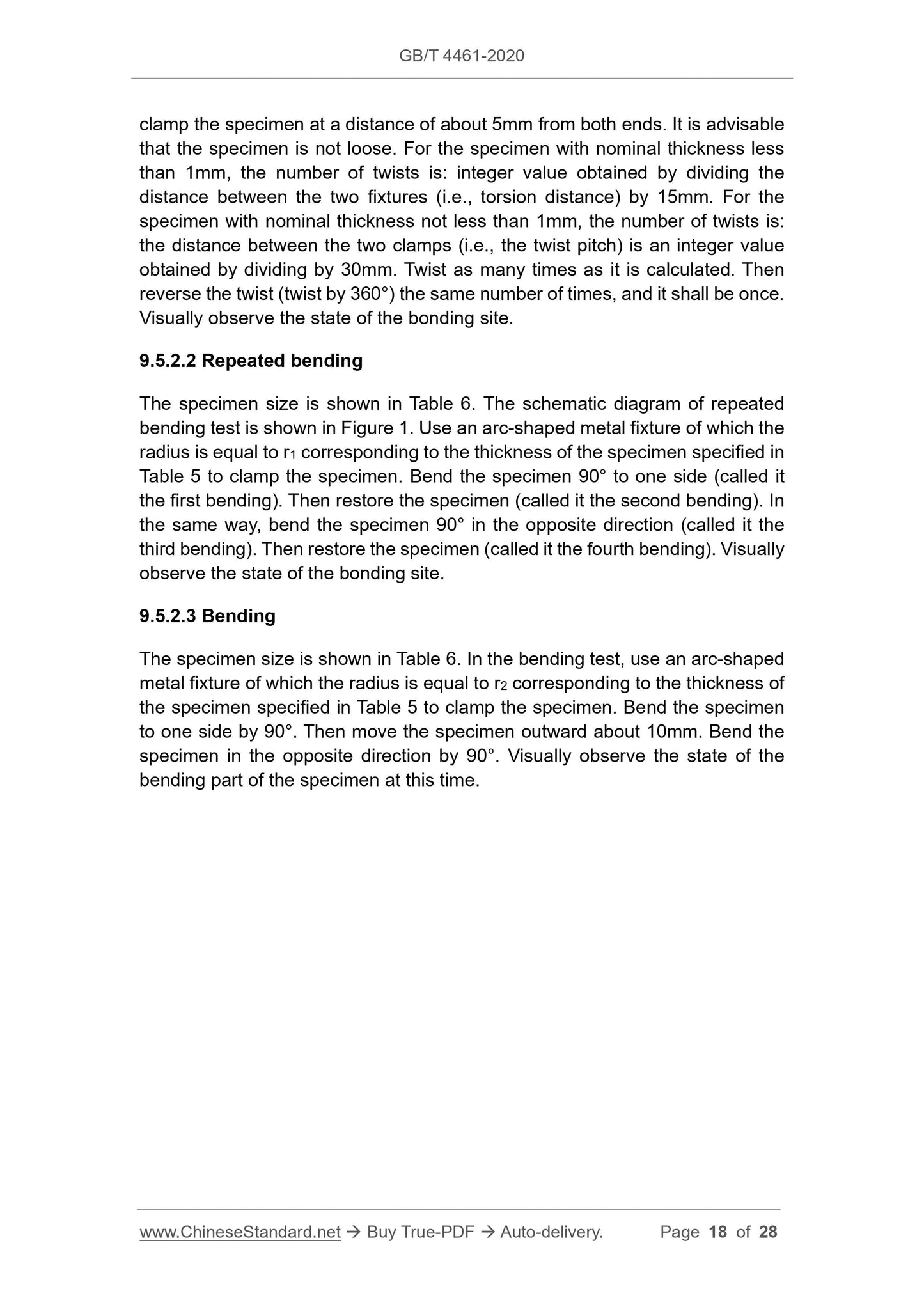1
/
of
7
www.ChineseStandard.us -- Field Test Asia Pte. Ltd.
GB/T 4461-2020 English PDF (GB/T4461-2020)
GB/T 4461-2020 English PDF (GB/T4461-2020)
Regular price
$320.00
Regular price
Sale price
$320.00
Unit price
/
per
Shipping calculated at checkout.
Couldn't load pickup availability
GB/T 4461-2020: Thermostat metal strip
Delivery: 9 seconds. Download (& Email) true-PDF + Invoice.
Get Quotation: Click GB/T 4461-2020 (Self-service in 1-minute)
Historical versions (Master-website): GB/T 4461-2020
Preview True-PDF (Reload/Scroll-down if blank)
GB/T 4461-2020
GB
NATIONAL STANDARD OF THE
PEOPLE’S REPUBLIC OF CHINA
ICS 77.140.99
H 58
Replacing GB/T 4461-2007
Thermostat metal strip
ISSUED ON: JUNE 02, 2020
IMPLEMENTED ON: DECEMBER 01, 2020
Issued by: State Administration for Market Regulation;
Standardization Administration of the People's Republic of
China.
Table of Contents
Foreword ... 3
1 Scope ... 5
2 Normative references ... 5
3 Terms and definitions ... 5
4 Designation representation method ... 8
5 Order content ... 9
6 Size and shape ... 9
7 Marks ... 10
8 Technical requirements ... 10
8 Surface quality ... 17
9 Test methods ... 17
10 Inspection rules ... 20
11 Packaging, signs and quality certificate... 21
Annex A (informative) Chemical composition of thermostat metal component
alloy ... 22
Annex B (informative) Average linear thermal expansion coefficient and
resistivity of thermostat metal component alloy... 25
Annex C (informative) Recommended heat treatment system ... 26
Bibliography ... 28
Thermostat metal strip
1 Scope
This Standard specifies the designation expression method, order content, size,
shape, marks, technical requirements, test methods, inspection rules,
packaging, signs and quality certificate for thermostat metal strip.
This Standard is applicable to the production of t thermostat metal strip
(hereinafter referred to as the strip) for thermal sensitive components in
temperature control, temperature compensation and temperature indicating
devices.
2 Normative references
The following referenced documents are indispensable for the application of
this document. For dated references, only the edition cited applies. For undated
references, the latest edition of the referenced document (including any
amendments) applies.
GB/T 5986, Test method for modulus of elasticity of thermostat metals
GB/T 6146, Test method for resistivity of precision resistance alloys
GB/T 8364, Test methods of thermal flexure of thermostat metals
YB/T 5242, General Rules of Packaging, Marking and Quality Certification
for Precision Alloys
3 Terms and definitions
For the purposes of this document, the following terms and definitions apply.
3.1 thermostat metal
A composite material for heat-sensitive elements that is composed of two or
more layers of metals or alloys with different average linear thermal expansion
coefficients that are firmly bonded along the entire contact surface.
NOTE: Rewrite definition 3.3.1 of GB/T 15014-2008.
3.2 component alloy
The collective name of the material layers that make up the thermostat metal.
According to the characteristics and functions of the material layer, it is divided
into active component of thermostat metal, passive component of thermostat
metal, intermediate passive component of thermostat metal.
[GB/T 15014-2008, definition 3.3.2]
3.2.1 active component of thermostat metal
A component layer with a larger average linear thermal expansion coefficient in
a thermostat metal.
NOTE 1: The active component of thermostat metal is also called the high expansion layer.
When the thermostat metal is heated and deformed, the active component of thermostat
metal is always on the convex side. The basic requirements for the materials of active
component of thermostat metal are: the average linear thermal expansion coefficient is
large; the structure is stable; the weldability is good when combined with other component
layer materials; the modulus of elasticity is close to that of the passive layer.
NOTE 2: Rewrite definition 3.3.5 of GB/T 15014-2008.
3.2.2 passive component of thermostat metal
The component layer with a relatively small average linear thermal expansion
coefficient in the thermostat metal.
NOTE 1: The passive component of thermostat metal is also called the low expansion layer.
When the thermostat metal is heated and deformed, the passive component of thermostat
metal is always on the concave side. The basic requirements for the materials of passive
component of thermostat metal are: in a certain temperature range, the average linear
thermal expansion coefficient value shall be small and the material structure shall be stable.
NOTE 2: Rewrite definition 3.3.4 of GB/T 15014-2008.
3.3 specific thermal deflection
For flat thermostat metal with unit thickness, when the temperature changes by
1°C, half of the curvature change along the longitudinal centerline.
The expression for specific thermal deflection K is:
Where,
K - specific thermal deflection, in per degree Celsius (°C-1);
δ - thickness of thermostat metal sheet, in millimeters (mm);
t1 - temperature when the thermostat metal sheet is flat, in Celsius (°C);
t2 - temperature when the thermostat metal sheet is bent, in Celsius (°C);
R - curvature radius of the thermostat metal sheet when bending, in millimeters
(mm).
NOTE: Rewrite definition 3.3.7 of GB/T 15014-2008.
3.4 flexivity
For a unit thickness of a thermostat metal sheet, the curvature of the
longitudinal centerline changes per unit temperature change.
The expression of flexivity F is:
Where,
F - flexivity, in per degree Celsius (°C-1);
δ - thickness of thermostat metal sheet, in millimeters (mm);
t1 - initial measured temperature of the thermostat metal sheet, in Celsius (°C);
t2 - end measured temperature of the thermostat metal sheet, in Celsius (°C);
R1 - radius of curvature of the longitudinal centerline of the specimen at the
initial measurement temperature of the thermostat metal sheet, in millimeters
(mm);
R2 - radius of curvature of the longitudinal centerline of the specimen at the end
measurement temperature of the thermostat metal sheet, in millimeters (mm).
NOTE: Rewrite definition 3.3.9 of GB/T 15014-2008.
3.5 elastic modulus of thermostat metal
Within the elastic limit of thermal bimetal, the ratio of stress to corresponding
8 Surface quality
The strip surface shall be smooth. Cracks, bubbles, flaking, rust spots, severe
scratches and harmful spots are not allowed. Burrs shall not exceed half of the
allowable thickness deviation.
9 Test methods
9.1 Size, shape
The size and shape of the strip are checked with measuring tools that can meet
the accuracy requirements.
9.2 Flexivity
The flexivity test and specimen preparation are carried out in accordance with
the provisions of GB/T 8364. Refer to Annex C for the heat treatment system of
the specimen.
9.3 Resistivity
The resistivity test is carried out according to the provisions of GB/T 6146. The
specimen size is shown in Table 6. It can also be measured with a bridge with
an accuracy of not less than level 0.05 or a potentiometer with an accuracy of
not less than level 0.03.
9.4 Elastic modulus
The elastic modulus test and specimen preparation are carried out in
accordance with the provisions of GB/T 5986. The specimen size is shown in
Table 6. Refer to Annex C for the heat treatment system of the specimen.
9.5 Bonding strength
9.5.1 Test method I
Test method I is repeated bending test (see Figure 1). The specimen size is
shown in Table 6. Repeatedly bend to break. Visually observe the state of the
bonding site.
9.5.2 Test method II
9.5.2.1 Twist
The specimen size is shown in Table 6. During the twist test, use a clamp to
clamp the specimen at a distance of about 5mm from both ends. It is advisable
that the specimen is not loose. For the specimen with nominal thickness less
than 1mm, the number of twists is: integer value obtained by dividing the
distance between the two fixtures (i.e., torsion distance) by 15mm. For the
specimen with nominal thickness not less than 1mm, the number of twists is:
the distance between the two clamps (i.e., the twist pitch) is an integer value
obtained by dividing by 30mm. Twist as many times as it is calculated. Then
reverse the twist (twist by 360°) the same number of times, and it shall be once.
Visually observe the state of the bonding site.
9.5.2.2 Repeated bending
The specimen size is shown in Table 6. The schematic diagram of repeated
bending test is shown in Figure 1. Use an arc-shaped metal fixture of which the
radius is equal to r1 corresponding to the thickness of the specimen specified in
Table 5 to clamp the specimen. Bend the specimen 90° to one side (called it
the first bending). Then restore the specimen (called it the second bending). In
the same way, bend the specimen 90° in the opposite direction (called it the
third bending). Then restore the specimen (called it the fourth bending). Visually
observe the state of the bonding site.
9.5.2.3 Bending
The specimen size is shown in Table 6. In the bending test, use an arc-shaped
metal fixture of which the radius is equal to r2 corresponding to the thickness of
the specimen specified in Table 5 to clamp the specimen. Bend the specimen
to one side by 90°. Then move the specimen outward about 10mm. Bend the
specimen in the opposite direction by 90°. Visually observe the state of the
bending part of the specimen at this time.
GB/T 4461-2020
GB
NATIONAL STANDARD OF THE
PEOPLE’S REPUBLIC OF CHINA
ICS 77.140.99
H 58
Replacing GB/T 4461-2007
Thermostat metal strip
ISSUED ON: JUNE 02, 2020
IMPLEMENTED ON: DECEMBER 01, 2020
Issued by: State Administration for Market Regulation;
Standardization Administration of the People's Republic of
China.
Table of Contents
Foreword ... 3
1 Scope ... 5
2 Normative references ... 5
3 Terms and definitions ... 5
4 Designation representation method ... 8
5 Order content ... 9
6 Size and shape ... 9
7 Marks ... 10
8 Technical requirements ... 10
8 Surface quality ... 17
9 Test methods ... 17
10 Inspection rules ... 20
11 Packaging, signs and quality certificate... 21
Annex A (informative) Chemical composition of thermostat metal component
alloy ... 22
Annex B (informative) Average linear thermal expansion coefficient and
resistivity of thermostat metal component alloy... 25
Annex C (informative) Recommended heat treatment system ... 26
Bibliography ... 28
Thermostat metal strip
1 Scope
This Standard specifies the designation expression method, order content, size,
shape, marks, technical requirements, test methods, inspection rules,
packaging, signs and quality certificate for thermostat metal strip.
This Standard is applicable to the production of t thermostat metal strip
(hereinafter referred to as the strip) for thermal sensitive components in
temperature control, temperature compensation and temperature indicating
devices.
2 Normative references
The following referenced documents are indispensable for the application of
this document. For dated references, only the edition cited applies. For undated
references, the latest edition of the referenced document (including any
amendments) applies.
GB/T 5986, Test method for modulus of elasticity of thermostat metals
GB/T 6146, Test method for resistivity of precision resistance alloys
GB/T 8364, Test methods of thermal flexure of thermostat metals
YB/T 5242, General Rules of Packaging, Marking and Quality Certification
for Precision Alloys
3 Terms and definitions
For the purposes of this document, the following terms and definitions apply.
3.1 thermostat metal
A composite material for heat-sensitive elements that is composed of two or
more layers of metals or alloys with different average linear thermal expansion
coefficients that are firmly bonded along the entire contact surface.
NOTE: Rewrite definition 3.3.1 of GB/T 15014-2008.
3.2 component alloy
The collective name of the material layers that make up the thermostat metal.
According to the characteristics and functions of the material layer, it is divided
into active component of thermostat metal, passive component of thermostat
metal, intermediate passive component of thermostat metal.
[GB/T 15014-2008, definition 3.3.2]
3.2.1 active component of thermostat metal
A component layer with a larger average linear thermal expansion coefficient in
a thermostat metal.
NOTE 1: The active component of thermostat metal is also called the high expansion layer.
When the thermostat metal is heated and deformed, the active component of thermostat
metal is always on the convex side. The basic requirements for the materials of active
component of thermostat metal are: the average linear thermal expansion coefficient is
large; the structure is stable; the weldability is good when combined with other component
layer materials; the modulus of elasticity is close to that of the passive layer.
NOTE 2: Rewrite definition 3.3.5 of GB/T 15014-2008.
3.2.2 passive component of thermostat metal
The component layer with a relatively small average linear thermal expansion
coefficient in the thermostat metal.
NOTE 1: The passive component of thermostat metal is also called the low expansion layer.
When the thermostat metal is heated and deformed, the passive component of thermostat
metal is always on the concave side. The basic requirements for the materials of passive
component of thermostat metal are: in a certain temperature range, the average linear
thermal expansion coefficient value shall be small and the material structure shall be stable.
NOTE 2: Rewrite definition 3.3.4 of GB/T 15014-2008.
3.3 specific thermal deflection
For flat thermostat metal with unit thickness, when the temperature changes by
1°C, half of the curvature change along the longitudinal centerline.
The expression for specific thermal deflection K is:
Where,
K - specific thermal deflection, in per degree Celsius (°C-1);
δ - thickness of thermostat metal sheet, in millimeters (mm);
t1 - temperature when the thermostat metal sheet is flat, in Celsius (°C);
t2 - temperature when the thermostat metal sheet is bent, in Celsius (°C);
R - curvature radius of the thermostat metal sheet when bending, in millimeters
(mm).
NOTE: Rewrite definition 3.3.7 of GB/T 15014-2...
Delivery: 9 seconds. Download (& Email) true-PDF + Invoice.
Get Quotation: Click GB/T 4461-2020 (Self-service in 1-minute)
Historical versions (Master-website): GB/T 4461-2020
Preview True-PDF (Reload/Scroll-down if blank)
GB/T 4461-2020
GB
NATIONAL STANDARD OF THE
PEOPLE’S REPUBLIC OF CHINA
ICS 77.140.99
H 58
Replacing GB/T 4461-2007
Thermostat metal strip
ISSUED ON: JUNE 02, 2020
IMPLEMENTED ON: DECEMBER 01, 2020
Issued by: State Administration for Market Regulation;
Standardization Administration of the People's Republic of
China.
Table of Contents
Foreword ... 3
1 Scope ... 5
2 Normative references ... 5
3 Terms and definitions ... 5
4 Designation representation method ... 8
5 Order content ... 9
6 Size and shape ... 9
7 Marks ... 10
8 Technical requirements ... 10
8 Surface quality ... 17
9 Test methods ... 17
10 Inspection rules ... 20
11 Packaging, signs and quality certificate... 21
Annex A (informative) Chemical composition of thermostat metal component
alloy ... 22
Annex B (informative) Average linear thermal expansion coefficient and
resistivity of thermostat metal component alloy... 25
Annex C (informative) Recommended heat treatment system ... 26
Bibliography ... 28
Thermostat metal strip
1 Scope
This Standard specifies the designation expression method, order content, size,
shape, marks, technical requirements, test methods, inspection rules,
packaging, signs and quality certificate for thermostat metal strip.
This Standard is applicable to the production of t thermostat metal strip
(hereinafter referred to as the strip) for thermal sensitive components in
temperature control, temperature compensation and temperature indicating
devices.
2 Normative references
The following referenced documents are indispensable for the application of
this document. For dated references, only the edition cited applies. For undated
references, the latest edition of the referenced document (including any
amendments) applies.
GB/T 5986, Test method for modulus of elasticity of thermostat metals
GB/T 6146, Test method for resistivity of precision resistance alloys
GB/T 8364, Test methods of thermal flexure of thermostat metals
YB/T 5242, General Rules of Packaging, Marking and Quality Certification
for Precision Alloys
3 Terms and definitions
For the purposes of this document, the following terms and definitions apply.
3.1 thermostat metal
A composite material for heat-sensitive elements that is composed of two or
more layers of metals or alloys with different average linear thermal expansion
coefficients that are firmly bonded along the entire contact surface.
NOTE: Rewrite definition 3.3.1 of GB/T 15014-2008.
3.2 component alloy
The collective name of the material layers that make up the thermostat metal.
According to the characteristics and functions of the material layer, it is divided
into active component of thermostat metal, passive component of thermostat
metal, intermediate passive component of thermostat metal.
[GB/T 15014-2008, definition 3.3.2]
3.2.1 active component of thermostat metal
A component layer with a larger average linear thermal expansion coefficient in
a thermostat metal.
NOTE 1: The active component of thermostat metal is also called the high expansion layer.
When the thermostat metal is heated and deformed, the active component of thermostat
metal is always on the convex side. The basic requirements for the materials of active
component of thermostat metal are: the average linear thermal expansion coefficient is
large; the structure is stable; the weldability is good when combined with other component
layer materials; the modulus of elasticity is close to that of the passive layer.
NOTE 2: Rewrite definition 3.3.5 of GB/T 15014-2008.
3.2.2 passive component of thermostat metal
The component layer with a relatively small average linear thermal expansion
coefficient in the thermostat metal.
NOTE 1: The passive component of thermostat metal is also called the low expansion layer.
When the thermostat metal is heated and deformed, the passive component of thermostat
metal is always on the concave side. The basic requirements for the materials of passive
component of thermostat metal are: in a certain temperature range, the average linear
thermal expansion coefficient value shall be small and the material structure shall be stable.
NOTE 2: Rewrite definition 3.3.4 of GB/T 15014-2008.
3.3 specific thermal deflection
For flat thermostat metal with unit thickness, when the temperature changes by
1°C, half of the curvature change along the longitudinal centerline.
The expression for specific thermal deflection K is:
Where,
K - specific thermal deflection, in per degree Celsius (°C-1);
δ - thickness of thermostat metal sheet, in millimeters (mm);
t1 - temperature when the thermostat metal sheet is flat, in Celsius (°C);
t2 - temperature when the thermostat metal sheet is bent, in Celsius (°C);
R - curvature radius of the thermostat metal sheet when bending, in millimeters
(mm).
NOTE: Rewrite definition 3.3.7 of GB/T 15014-2008.
3.4 flexivity
For a unit thickness of a thermostat metal sheet, the curvature of the
longitudinal centerline changes per unit temperature change.
The expression of flexivity F is:
Where,
F - flexivity, in per degree Celsius (°C-1);
δ - thickness of thermostat metal sheet, in millimeters (mm);
t1 - initial measured temperature of the thermostat metal sheet, in Celsius (°C);
t2 - end measured temperature of the thermostat metal sheet, in Celsius (°C);
R1 - radius of curvature of the longitudinal centerline of the specimen at the
initial measurement temperature of the thermostat metal sheet, in millimeters
(mm);
R2 - radius of curvature of the longitudinal centerline of the specimen at the end
measurement temperature of the thermostat metal sheet, in millimeters (mm).
NOTE: Rewrite definition 3.3.9 of GB/T 15014-2008.
3.5 elastic modulus of thermostat metal
Within the elastic limit of thermal bimetal, the ratio of stress to corresponding
8 Surface quality
The strip surface shall be smooth. Cracks, bubbles, flaking, rust spots, severe
scratches and harmful spots are not allowed. Burrs shall not exceed half of the
allowable thickness deviation.
9 Test methods
9.1 Size, shape
The size and shape of the strip are checked with measuring tools that can meet
the accuracy requirements.
9.2 Flexivity
The flexivity test and specimen preparation are carried out in accordance with
the provisions of GB/T 8364. Refer to Annex C for the heat treatment system of
the specimen.
9.3 Resistivity
The resistivity test is carried out according to the provisions of GB/T 6146. The
specimen size is shown in Table 6. It can also be measured with a bridge with
an accuracy of not less than level 0.05 or a potentiometer with an accuracy of
not less than level 0.03.
9.4 Elastic modulus
The elastic modulus test and specimen preparation are carried out in
accordance with the provisions of GB/T 5986. The specimen size is shown in
Table 6. Refer to Annex C for the heat treatment system of the specimen.
9.5 Bonding strength
9.5.1 Test method I
Test method I is repeated bending test (see Figure 1). The specimen size is
shown in Table 6. Repeatedly bend to break. Visually observe the state of the
bonding site.
9.5.2 Test method II
9.5.2.1 Twist
The specimen size is shown in Table 6. During the twist test, use a clamp to
clamp the specimen at a distance of about 5mm from both ends. It is advisable
that the specimen is not loose. For the specimen with nominal thickness less
than 1mm, the number of twists is: integer value obtained by dividing the
distance between the two fixtures (i.e., torsion distance) by 15mm. For the
specimen with nominal thickness not less than 1mm, the number of twists is:
the distance between the two clamps (i.e., the twist pitch) is an integer value
obtained by dividing by 30mm. Twist as many times as it is calculated. Then
reverse the twist (twist by 360°) the same number of times, and it shall be once.
Visually observe the state of the bonding site.
9.5.2.2 Repeated bending
The specimen size is shown in Table 6. The schematic diagram of repeated
bending test is shown in Figure 1. Use an arc-shaped metal fixture of which the
radius is equal to r1 corresponding to the thickness of the specimen specified in
Table 5 to clamp the specimen. Bend the specimen 90° to one side (called it
the first bending). Then restore the specimen (called it the second bending). In
the same way, bend the specimen 90° in the opposite direction (called it the
third bending). Then restore the specimen (called it the fourth bending). Visually
observe the state of the bonding site.
9.5.2.3 Bending
The specimen size is shown in Table 6. In the bending test, use an arc-shaped
metal fixture of which the radius is equal to r2 corresponding to the thickness of
the specimen specified in Table 5 to clamp the specimen. Bend the specimen
to one side by 90°. Then move the specimen outward about 10mm. Bend the
specimen in the opposite direction by 90°. Visually observe the state of the
bending part of the specimen at this time.
GB/T 4461-2020
GB
NATIONAL STANDARD OF THE
PEOPLE’S REPUBLIC OF CHINA
ICS 77.140.99
H 58
Replacing GB/T 4461-2007
Thermostat metal strip
ISSUED ON: JUNE 02, 2020
IMPLEMENTED ON: DECEMBER 01, 2020
Issued by: State Administration for Market Regulation;
Standardization Administration of the People's Republic of
China.
Table of Contents
Foreword ... 3
1 Scope ... 5
2 Normative references ... 5
3 Terms and definitions ... 5
4 Designation representation method ... 8
5 Order content ... 9
6 Size and shape ... 9
7 Marks ... 10
8 Technical requirements ... 10
8 Surface quality ... 17
9 Test methods ... 17
10 Inspection rules ... 20
11 Packaging, signs and quality certificate... 21
Annex A (informative) Chemical composition of thermostat metal component
alloy ... 22
Annex B (informative) Average linear thermal expansion coefficient and
resistivity of thermostat metal component alloy... 25
Annex C (informative) Recommended heat treatment system ... 26
Bibliography ... 28
Thermostat metal strip
1 Scope
This Standard specifies the designation expression method, order content, size,
shape, marks, technical requirements, test methods, inspection rules,
packaging, signs and quality certificate for thermostat metal strip.
This Standard is applicable to the production of t thermostat metal strip
(hereinafter referred to as the strip) for thermal sensitive components in
temperature control, temperature compensation and temperature indicating
devices.
2 Normative references
The following referenced documents are indispensable for the application of
this document. For dated references, only the edition cited applies. For undated
references, the latest edition of the referenced document (including any
amendments) applies.
GB/T 5986, Test method for modulus of elasticity of thermostat metals
GB/T 6146, Test method for resistivity of precision resistance alloys
GB/T 8364, Test methods of thermal flexure of thermostat metals
YB/T 5242, General Rules of Packaging, Marking and Quality Certification
for Precision Alloys
3 Terms and definitions
For the purposes of this document, the following terms and definitions apply.
3.1 thermostat metal
A composite material for heat-sensitive elements that is composed of two or
more layers of metals or alloys with different average linear thermal expansion
coefficients that are firmly bonded along the entire contact surface.
NOTE: Rewrite definition 3.3.1 of GB/T 15014-2008.
3.2 component alloy
The collective name of the material layers that make up the thermostat metal.
According to the characteristics and functions of the material layer, it is divided
into active component of thermostat metal, passive component of thermostat
metal, intermediate passive component of thermostat metal.
[GB/T 15014-2008, definition 3.3.2]
3.2.1 active component of thermostat metal
A component layer with a larger average linear thermal expansion coefficient in
a thermostat metal.
NOTE 1: The active component of thermostat metal is also called the high expansion layer.
When the thermostat metal is heated and deformed, the active component of thermostat
metal is always on the convex side. The basic requirements for the materials of active
component of thermostat metal are: the average linear thermal expansion coefficient is
large; the structure is stable; the weldability is good when combined with other component
layer materials; the modulus of elasticity is close to that of the passive layer.
NOTE 2: Rewrite definition 3.3.5 of GB/T 15014-2008.
3.2.2 passive component of thermostat metal
The component layer with a relatively small average linear thermal expansion
coefficient in the thermostat metal.
NOTE 1: The passive component of thermostat metal is also called the low expansion layer.
When the thermostat metal is heated and deformed, the passive component of thermostat
metal is always on the concave side. The basic requirements for the materials of passive
component of thermostat metal are: in a certain temperature range, the average linear
thermal expansion coefficient value shall be small and the material structure shall be stable.
NOTE 2: Rewrite definition 3.3.4 of GB/T 15014-2008.
3.3 specific thermal deflection
For flat thermostat metal with unit thickness, when the temperature changes by
1°C, half of the curvature change along the longitudinal centerline.
The expression for specific thermal deflection K is:
Where,
K - specific thermal deflection, in per degree Celsius (°C-1);
δ - thickness of thermostat metal sheet, in millimeters (mm);
t1 - temperature when the thermostat metal sheet is flat, in Celsius (°C);
t2 - temperature when the thermostat metal sheet is bent, in Celsius (°C);
R - curvature radius of the thermostat metal sheet when bending, in millimeters
(mm).
NOTE: Rewrite definition 3.3.7 of GB/T 15014-2...
Share
